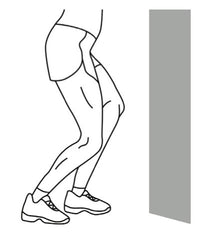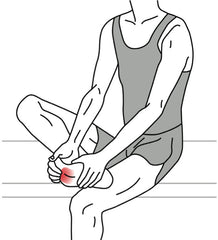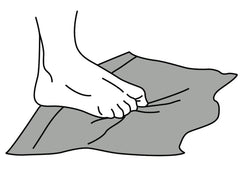Simple Self Help Tips for Plantar Fasciitis
Posted by Stuart Hinds on
Plantar Fasciitis - How To Treat Your Own Trigger Points
The plantar fascia supports the arch of the foot and if strained, become weak, swollen, and inflamed
Plantar Fasciitis is the most frequent injury of the plantar fascia. It refers to the inflammation of a thick band of tissue that runs across the bottom of the foot and connects the heel bone to the toes.
The plantar fascia supports the arch of the foot and if strained, becomes weak, swollen and inflamed. Repeated strain can bring about small tears in the ligament causing pain and swelling.
Repeated injuries to the plantar fascia seem to be the main cause of plantar fasciitis which can develop in one or both feet.
Trigger Points
Interestingly, plantar fasciitis almost always generates a pain map that emanates from trigger points in the quadratus plantae, soleus, and gastrocnemius muscles. Treating these trigger points should provide both short- and long-term relief.
As is often the case with trigger points, the therapy works best when the client continues to perform self-help procedures between treatments.
Below you'll find some examples of self-help that we will often prescribe when treating this condition:
1. Gastrocnemius (calf muscle ) stretch

- Stand on the edge of a ledge (somewhere sufficiently stable to support your body weight)
- You will need to have enough of your foot on the edge of the ledge so that it does not slip off. Make sure you are stable, this will allow you to hold your stretch for a longer period (better quality of stretch)
- Lower both heels over the edge of the ledge
- Try lowering one leg at a time. This increases the weight on the calf muscle and increases the intensity of the stretch
- You should feel the stretch move lower and to the inside of the shin
- Hold the stretch for between 30-50 seconds, 3 times each side every two to three hours
2. Soleus Stretch

- To stretch the soleus muscle the back leg should be bent
- Place the leg to be stretched behind and lean against a wall keeping the heel down
- A stretch should be felt lower down nearer the ankle at the back of the leg
- If this stretch is not felt then try to place the forefoot of the front leg against the wall with the heel on the floor and push the front knee towards the wall
- Hold for 30-50 seconds repeat 3 times one each leg. 3 times each side, twice daily
3. Stretching the deep foot flexors

- In sitting position, gently hold foot with one hand
- With the opposite hand pull all five toes up towards the body
- Hold for 30-50 seconds, twice each side, twice daily
4. Towel lifts

- Place a hand towel on the floor. The towel should be completely flat
- Stand with your foot over the towel and use your toes and the bottom of your foot to scrunch up the towel
- Next use your toes and feet to flatten the towel
- Repeat 10 times, 3 times daily
5. Taping
There's a lot of conflicting talk around taping and not too much evidence. In our experience, taping is often a useful adjunct to the treatment process, and clients certainly seem to feel the benefit.
One thing for sure is that there's absolutely no harm in it so long as you're careful with the scissors!
We don't recommend taping too often for self-help, but this is quite an easy area to tape and most clients seem to manage it quite well.
We'd always recommend getting a friend or partner to help even if it's just to hold the scissors or prepare the next piece of tape.
Most pharmacies stock kinesiology tape nowadays, and they should be able to recommend the right tape for you.

- Measure tape from heel from the ball of the foot and cut to that length. Cut it into to four tails leaving the last 2 inches uncut as an anchor (you can use a solid strip if you have a problem with the tails loosening)
- Flex your foot pointing your toes up, and anchor the 2-inch base to the heel
- Apply the tails towards your toes with no stretch
- Measure another piece of tape around your foot
- Anchor this strip at the outside top edge of your foot. Tape from outside to inside to support the arch, pulling up a little with the tape at the end
- Lay down the end with no tension on the top of your foot
- Gently run over the tape with hand to provide some pressure. The tape should stay on for a few days, thereafter it will start to peel. At this point, it can be removed and reapplied with a new strip

NAT - Trigger Point Foundation Course (10 CPE)
About the author
Stuart Hinds is one of Australia’s leading soft tissue therapists, with over 27 years of experience as a practitioner, working with elite sports athletes, supporting Olympic teams, educating and mentoring others as well as running a highly successful clinic in Geelong.
Stuart has a strong following of practitioners across Australia and globally who tap into his expertise as a soft-tissue specialist. He delivers a range of highly sought after seminars across Australia, supported by online videos, webinars and one-on-one mentoring to help support his colleagues to build successful businesses.
In 2016, Stuart was awarded a lifetime membership to Massage & Myotherapy Australia for his significant support and contribution to the industry.
* * *
This trigger point therapy blog is intended to be used for information purposes only and is not intended to be used for medical diagnosis or treatment or to substitute for a medical diagnosis and/or treatment rendered or prescribed by a physician or competent healthcare professional. This information is designed as educational material, but should not be taken as a recommendation for treatment of any particular person or patient. Always consult your physician if you think you need treatment or if you feel unwell.
Liquid error (sections/article-template line 26): Could not find asset snippets/relatedblogs.liquidShare this post
- 0 comment
- Tags: Foot, plantar fasciitis, self-help
